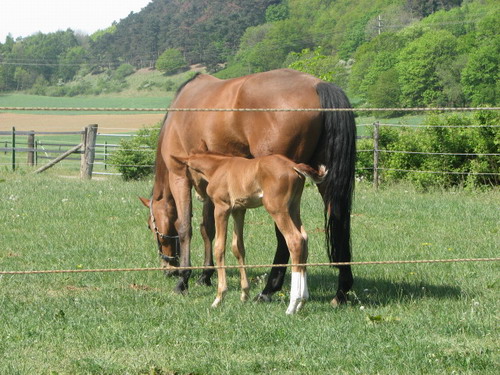Hanoverian horse – the all-rounder from Germany
Ratina Z, Shutterfly, Checkmate or Gigolo: all these famous sport horses come from the same breed: The Hanoverian horse.
Originally this breed comes from Lower Saxony which is one of the northern Federal States in Germany.
Today you can find at least one Hanoverian horse in every famous horse sport discipline. There are famous representatives in the disciplines of dressage, show jumping, eventing and combined driving. However this breed is not only perfect for any kinds of professional sports but also as a recreational horse. Many riders love this warmblood and appreciate its versatility.
History of the Hanoverian breed
 The professional breed of the Hanoverian horse started in the 16. century. Originally this warmblood was used for military and agricultural needs. The breed of the Hanoverian horses was really profitable for the farmers in Niedersachsen and at the same time the only way to earn much money. Referring to this the existence of the farmers was dependent on the breed of the horses. 1735 the stud in Celle was founded and from that time one there was a central registration of all coverings and births of foals. At the time of 1800 the stud already had 100 stallions which were send to more than 50 farms all over the country.
The professional breed of the Hanoverian horse started in the 16. century. Originally this warmblood was used for military and agricultural needs. The breed of the Hanoverian horses was really profitable for the farmers in Niedersachsen and at the same time the only way to earn much money. Referring to this the existence of the farmers was dependent on the breed of the horses. 1735 the stud in Celle was founded and from that time one there was a central registration of all coverings and births of foals. At the time of 1800 the stud already had 100 stallions which were send to more than 50 farms all over the country.
At the beginning of the 19. century the Hanoverian horses were crossed with Arabian and English horses because they wanted to get more temperament into the breed. In the 1870s they were additionally crossed with regional German horses and this improved the quality as a coach and military horse. 1888 the Hanoverian “Stutbuch” was founded which is a register for all mares which are used for the breed. Finally, in 1922, the Hanoverian association for breed was founded.
In the times of the second world war breeders especially wanted horses for the military and agricultural purpose. After the war there was a complete restructuring of the breed because the professional equestrianism became more and more popular. Through the further influence of Trakehners and Arabian horses the Hanoverian horse became what is today: a noble, powerful and reliable warmblood horse for the professional and recreational use.
Characteristics of the Hanoverian horse
The Hanoverian horse is characterized by a balanced and reliable temperament with strong nerves. They are easy to handle and uncomplicated but at the same time they have a sensitive character. Additionally they offer a high motivation and much courage what makes them perfect for any sport disciplines.
 External Characteristics
External Characteristics
Hanoverian horses are breed in the four colors of sorrels, blacks, browns and grays. The average of the hands high is 1,65 m but there are many horses which differ from this height. Referring to this there are graceful horses with a hh of 1,60m as well as strong and powerful couch horses with a hh of more than 1,80 m.
The aims of the Hanoverian breed show a horse with a noble outward appearance and a clear outline: a strong musculature, a noble shape of the head, a long, strong and fitting neck as well as a long and oblique shoulder. The horses shall present a rectangle what means that the size of the legs is in a perfect proportion with the length of the back.
Hanoverian horses walk in a swinging, regular and powerful way. Generally the breed of this species excludes any kinds of hereditary diseases.
The Hanoverian horse nowadays
The present Hanoverian breed is specialized on the different disciplines of dressage, show jumping and eventing. Therefore the breeders offer separate breed lines which concentrate on the respective characteristics of the discipline. Additionally there is a further focus on the recreational use. These horses are perfect for any kind of unprofessional riding and even for beginners.
The stud in Celle/Lower Saxony offers more than 140 active stallions with ten Arabian and two Anglo-Arabian horses. Besides there are about 40 young stallions (three years old) which become prepared for the stallion testing. If you want to see the stallions and their powerful movement you can come and visit the stallion parade in Celle which always takes place in September and October.
You can find Hanoverian horses in every stable. Riding schools appreciate their reliability and versatility so that they can be used for beginners and professionals. Private breeders offer information days on which interested riders can get in touch with this unique horse species.
Surftips:
- Colored Horses- Pintos, Multicolored Beauties
- The Wild Horses of Namibia- Namib Desert Horses
- The Arravani- The Multifunctional Greek Horse
—All statements without guarantee—

